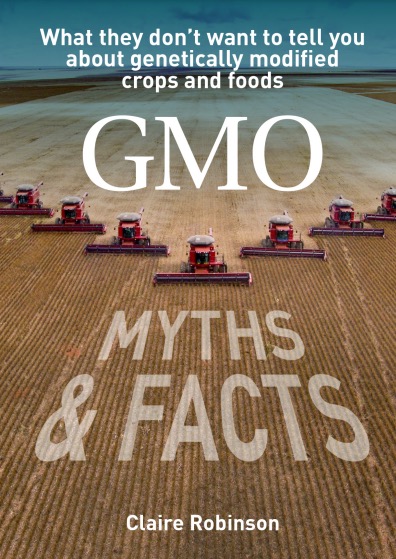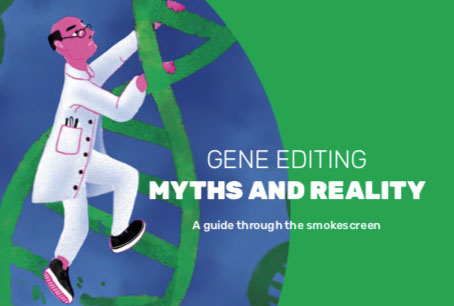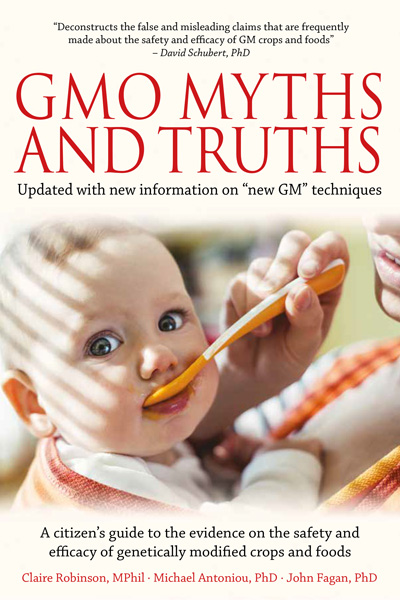
Warning signs are dismissed for the flimsiest of reasons, a new peer-reviewed article shows. Report: Claire Robinson
UK, US and European regulatory institutions have for many years been repeatedly subjecting evidence of possible harm from constituents of our food supply to severe critical scrutiny, while accepting seemingly reassuring studies and data uncritically, a new peer-reviewed article shows.
Drawing on the details of regulatory debates over four key issues, including the sole GM maize variety that's approved to grow in the EU (MON810) and glyphosate, the authors (van Zwanenberg et al) document regulators’ consistently asymmetric treatment of evidence (more commonly known as “double standards”), which has served to benefit commercial interests to the detriment of consumer protection.
Mad cow disease – a cautionary tale
Van Zwanenberg et al present a cautionary tale in the form of the UK government’s disastrous handling of the BSE (“mad cow disease”) epidemic. Eating food from BSE-infected cattle caused a fatal brain disease in humans – but this was only admitted by the government a decade after BSE had first been identified. During that decade, medical and veterinary officials and ministers insisted repeatedly that BSE posed no threat to human health.
A subsequent public inquiry identified many “shortcomings” in the UK government’s management of BSE, but it emphasised that a fundamental problem was the pervasive failure to acknowledge and respond adequately to scientific uncertainties. Officials and expert advisors to the government continued to push the notion that BSE was harmless as if it was a robust fact, whereas in fact it consisted of little more than “guess work”.
At the same time, evidence that undermined the dominant theory was glossed over or ignored: “The handful of academic scientists who insisted on discussing those alternative hypotheses in public and their implications (which were that we had no idea of the potential risks to humans) were treated with hostility and contempt by ministers and officials.”
Four case examples
Van Zwanenberg et al then examine four case examples of asymmetric regulatory evaluations of chemicals and foods: ethylene bisdithiocarbamate fungicides, MON810 Bt toxin-containing insecticidal maize, the artificial sweetener aspartame, and the herbicide glyphosate. They find that “evidence that those products were unlikely to be harmful was routinely accepted by regulatory bodies as reliable, relevant, and sufficient to support judgements of safety, even when that evidence was incomplete, equivocal or the underlying studies were inadequate or flawed or both. By contrast, evidence indicating possible or actual hazards and risks was subjected to far more critical scrutiny to try to discern any possible grounds for discounting it, including reasons that were deemed not to be a problem when they characterised evidence indicative of a lack of harm, or when those reasons were entirely speculative or were contradicted by available evidence.”
EFSA GMO Panel member admits bias
As van Zwanenberg et al recount, this asymmetric and biased approach was explicitly admitted to by a former European Food Safety Authority (EFSA) GMO Panel member who stated: “Of course, studies that describe potential negative [i.e., adverse] environmental effects of GMOs are discussed particularly intensively.” In line with this approach, studies conducted by Dr Angelika Hilbeck’s team, which showed harmful effects of Bt toxin fed to non-target beneficial insects (lacewings), were dismissed by EFSA and the US EPA. They achieved this dismissal “based on standards that were not applied to all the work reviewed” by the EPA, as noted by the EPA’s Federal Insecticide, Fungicide and Rodenticide Act Scientific Advisory Panel, which is responsible for providing oversight of the scientific quality of EPA decision-making on pesticide-related issues.
Notoriously, EFSA and the EPA had accepted industry studies as proof of safety of MON810 to non-target insects even though it was almost certain that the insect test subjects had not been able to ingest the Bt toxin because it was fed to them in a way that made it impossible for them to eat. When Hilbeck and her team fed the Bt toxin to the insects in a way that made certain they ate it, harmful effects were found.
However, both the UK and US advisors outlined speculative reasons as to why the harm observed in Hilbeck’s laboratory studies might not materialise in farmers’ fields. The UK advisory body ACRE suggested that lacewing larvae would have a wider variety of plants to eat under field conditions (and thus be exposed to less GM maize in their diet), and they might be healthier than in a laboratory setting, and so more resistant to the Bt toxin. Reassured by these baseless speculations, the regulators did nothing to ban or restrict MON810's cultivation. It is still authorised to be grown in the EU, albeit only small amounts are cultivated in Spain and Portugal.
Why do they do it?
Van Zwanenberg et al question why officials and advisors engage in, or endorse, such asymmetric evaluative practices, and outline a few possible reasons:
* Resource or time constraints, and/or a culture of mutual trust between regulators and industry, mean that institutions responsible for regulatory appraisals may uncritically reproduce industrial firms’ own, self-interested asymmetric assessments of evidence. For example, the German regulatory agency BfR’s asymmetrical evaluation of glyphosate’s genotoxicity data almost closely mirrored Monsanto's assessment.
* Officials and advisors in risk assessment institutions may share, or are chosen because they share, a broader policy presumption to favour industrial innovation and/or the status quo unless there is direct and strong evidence that a technological product causes unacceptable harm.
* Officials employed in and by science-based regulatory institutions have organisational incentives to protect the reputation of the institution in which they work, by trying to give the impression that the institution had never previously made any mistakes. This produces “institutional inertia”. If a science-based technology regulatory institution changes its regulatory judgements or recommendations, without new evidence that could be portrayed as legitimating those changes, then the institution would in effect be admitting that it had previously made mistakes in its judgements and advice. Such an admission would provoke questions along the lines of: which other mistakes have you made?
Recommendations
Van Zwanenberg et al suggest ways in which the above-listed biased practices might be diminished:
* Regulatory institutions need sufficient resources to perform their own independent analyses of unpublished and peer-reviewed evidence and, more generally, a culture that recognises, and can respond procedurally to, the fact that industrial actors have commercial interests in portraying evidence about their products in as favourable a way as is possible to sustain.
* Reforms to limit unwarranted political influence on scientific appraisals and/or its representations by policy-makers and the regulated industries have already long been introduced, but they don’t appear to have succeeded in reducing asymmetric evaluations of evidence. Possible reasons are that the reforms have only been partially implemented, or that they are not strong enough, or that the problem lies elsewhere, such as in regulatory cultures that have long followed permissive, non-precautionary approaches to analysis.
This important paper should be compulsory reading for all members of regulatory agencies worldwide and they should be held accountable for their many failures to apply consistent standards to evaluating evidence indicating harm and absence of harm.
---
Asymmetric evaluations of scientific evidence indicating harm compared to evidence indicating an absence of harm in regulatory appraisals
Patrick van Zwanenberg, Erik Millstone and Alice Livingston Ortolani
Environmental Sciences Europe volume 37, Article number: 138 (2025)
https://enveurope.springeropen.com/articles/10.1186/s12302-025-01176-9
Abstract
This paper asks whether, when assessing the safety of regulated products, the standards of scrutiny and evaluation deployed by regulatory officials and scientific advisors differ for evidence indicating that a product might be harmful compared to evidence indicating an absence of harm. Four cases from the field of food chemical regulation are analysed for which safety appraisals were conducted by European and US regulatory institutions between the late 1980s and the 2010s. The cases concern selected areas of the possible toxicity of ethylene bisdithiocarbamate fungicides, a genetically modified variety of Bt maize, the artificial sweetener aspartame, and the herbicide glyphosate. We find that evidence that those products were unlikely to be harmful was routinely accepted by regulatory bodies as reliable, relevant, and sufficient to support judgements of safety, even when that evidence was incomplete, equivocal or the underlying studies were inadequate or flawed or both. By contrast, evidence indicating possible or actual hazards and risks was subjected to far more critical scrutiny to try to discern any possible grounds for discounting it, including reasons that were deemed not to be a problem when they characterised evidence indicative of a lack of harm, or when those reasons were entirely speculative or were contradicted by available evidence. We identify and characterise several different types of evaluative asymmetry and argue that all are antithetical to the effective protection of public and environmental health. Several also violate indispensable scientific requirements for making valid inferences and reaching well-founded conclusions; that is, they are scientifically defective. Their deployment misleads many policy decision makers and most of the public. Their effect is to conceal the scope for diminishing possible harm. We outline hypotheses as to why asymmetric patterns of scrutiny and evaluation appear to be a relatively widespread phenomena across different regulatory jurisdictions and time periods.
Image: Shutterstock (licensed purchase)










